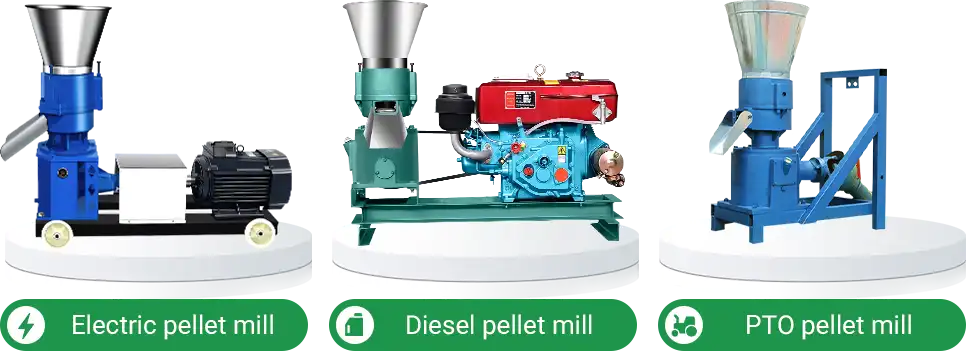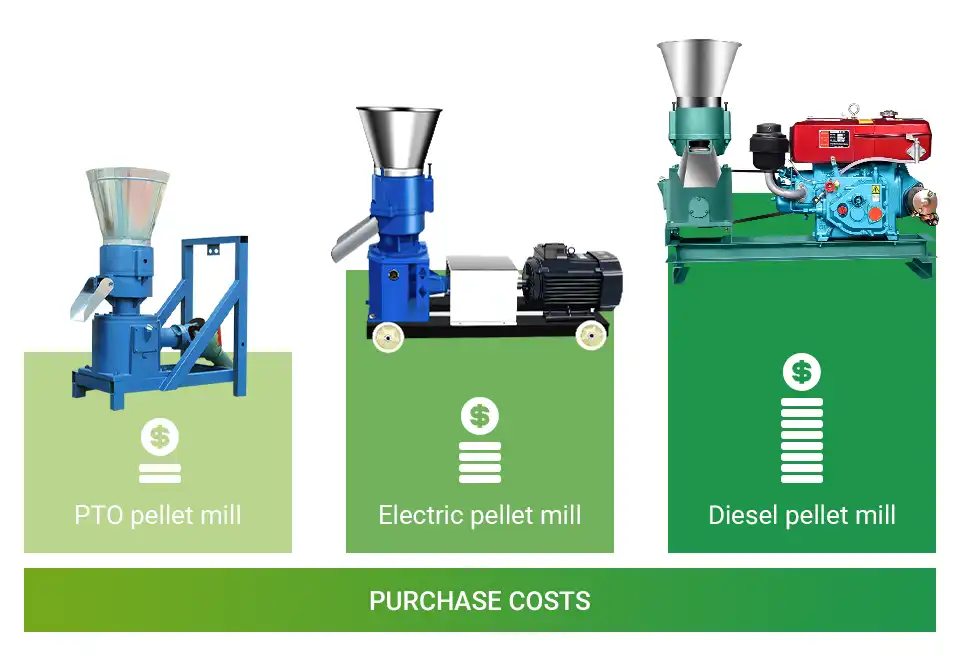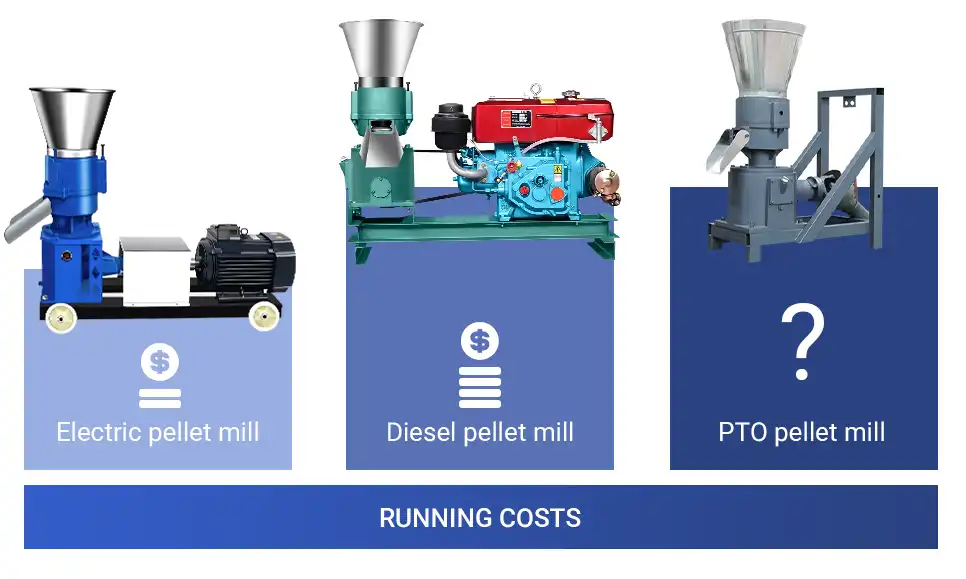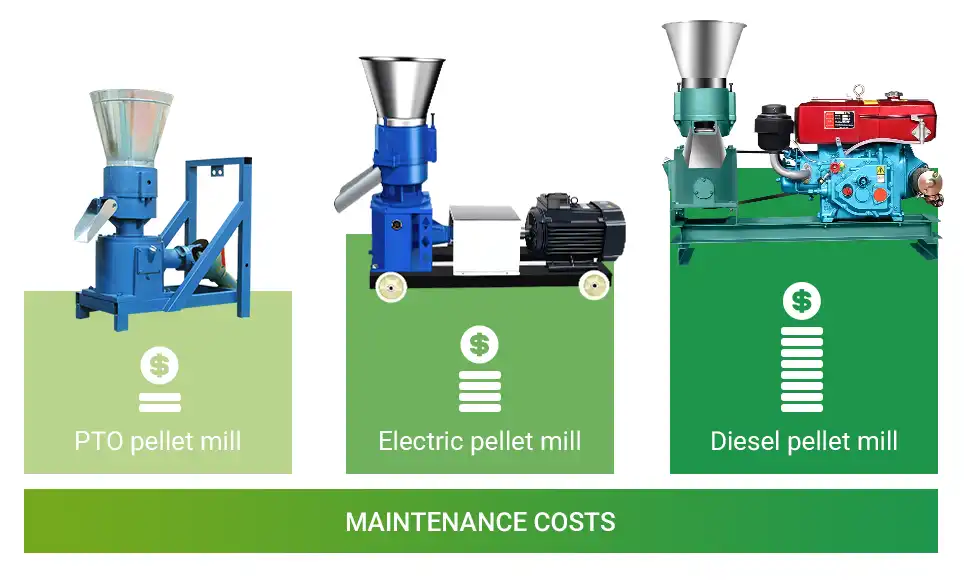There are three main types of pellet machines, classified by their power source: electric pellet mill, diesel pellet mill, and PTO pellet mill. To assist you in selecting the most suitable option, we will explain the key distinctions.

Electric vs. Diesel vs. PTO Pellet Mills
Comparison of three pellet mill types.
| Feature | Electric Pellet Mill | Diesel Pellet Mill | PTO Pellet Mill |
| Weight | Relatively light | Heavier overall | Lightest among the three |
| Mobility | Limited (depends on power supply) | Best (ideal for off-grid areas) | Good (flexible with tractor or machinery) |
| Noise Level | Low | High | Moderate (depends on power equipment) |
| Power Source | Electricity | Diesel engine | Tractor PTO or farm machinery PTO |
| Ease of Operation | Easy | Moderate (engine experience required) | Moderate (PTO connection knowledge required) |
| Production Capacity | Same | Same | Same |
| Material Processing | Similar materials | Similar materials | Similar materials |
| Environmental Impact | Most eco-friendly, no emissions | Higher emissions | Depends on tractor or machinery used |
Here’s a detailed cost comparison of the three pellet mills. You’ll see the purchase, running, and maintenance costs at a glance.
Purchase Costs
Electric Pellet Machine – Affordable and Simple
The electric pellet machine comes with either a three-phase or single-phase motor. Its simple design and lower power cost make it more affordable than diesel models. It's a good choice for budget-conscious buyers.
Diesel Pellet Machine – More Expensive, High Power
The diesel pellet machine runs on a diesel engine. It comes with a fuel system, cooling system, and several transmission components. Its more complex design compared to electric models results in higher production costs and, consequently, a steeper purchase price.
PTO Pellet Machine – Cheapest (If You Have a Tractor)
It’s the most budget-friendly option. There is no built-in power source for the PTO pellet machine. It runs using tractors or other farm equipment with a PTO connection. The price of a tractor or other appropriate power source will need to be considered if you do not already own comparable equipment.

Running Costs
Electric Pellet Mill– Low Operating Cost
An electric pellet mill with a 22 kW power rating and a capacity of 300-450 kg/h consumes about 0.049–0.073 kWh/kg. The average U.S. electricity price is $0.179 per kWh as of February 2025. Based on this, the electricity cost per kilogram of pellets is about $0.0087 to $0.0131.
Diesel Pellet Mill– Higher Fuel Expenses
A 22-horsepower diesel powered pellet mill with a production capacity of 150–220 kg/h consumes about 0.0218–0.0267 L/kg of diesel. The average U.S. on-highway diesel price is $0.971/L (February 2025). At this rate, the fuel cost per kilogram of pellets is roughly $0.0212–$0.0259.
You can use off-highway (red) diesel, which is usually cheaper, to further lower your fuel costs.
PTO Pellet Mill – Depends on Your Tractor's Fuel Use
The running cost of a PTO-driven pellet mill depends on the fuel consumption of the connected power equipment. Fuel use changes with the power rating and workload. Actual fuel usage can fluctuate widely according to operating conditions, making precise estimates difficult.
(Note: The fuel and electricity consumption figures provided are industry estimates for feed pellet production. Actual consumption may differ depending on factors such as equipment, raw materials, and operating conditions. These numbers are for reference only.)

Maintenance Costs
Electric Pellet Machine– Easy to Maintain
Maintenance costs are usually minimal, mainly involving regular lubrication, cleaning, and replacing key components.
For example, bearings under heavy load should have their lubrication checked every 8 hours of operation. Pellet dies typically need to be replaced after around 800–1500 hours of use.(The dies on diesel and PTO pellet machines also need to be replaced regularly based on usage and wear.)
Diesel Pellet Machine– Requires Regular Engine Care
Diesel pellet mills tend to have higher maintenance costs. This is mainly because of fuel system checks and cooling system upkeep.
For instance, engine oil should be replaced every 50–100 hours of operation. Fuel and oil filters should be inspected and replaced every 100–200 hours.
PTO Pellet Machine– Minimal, Mostly Tractor Maintenance
The PTO pellet mill has low maintenance costs, mainly for inspecting and maintaining the PTO driveline and key components. (For example, lubricating the universal joint every 10–20 operating hours.) Maintenance costs also depend on the upkeep and fuel consumption of the connected power equipment.
(Note: Actual maintenance costs will vary depending on usage frequency, machine model, and overall care. For accurate guidance, please refer to the maintenance schedule and care instructions provided in your equipment's user manual.)

Pellet Mill Cost Comparison Guide
| Feature | Electric Pellet Mill | Diesel Pellet Mill | PTO Pellet Mill |
| Purchase Cost | Lower | Higher | Lowest (if compatible power equipment is already available) |
| Running Cost | Lower | Moderate | Depends on the fuel consumption of the power equipment |
| Maintenance Cost | Lower | Higher | Low for the machine itself, but consider maintenance of the power equipment |
- Electric Pellet Mill: Best for areas with stable electricity supply, focusing on budget and ease of use.
- Diesel Pellet Mill: Ideal for remote or off-grid areas, or places with high electricity costs, requiring mobility.
- PTO Pellet Mill: Perfect for users with existing PTO-powered equipment, saving on power equipment costs.
If you need a detailed cost analysis or help choosing the right model, contact us for a customized solution tailored to your needs.





